 
Colectomatic Mark II
The Duo-Press Revolution
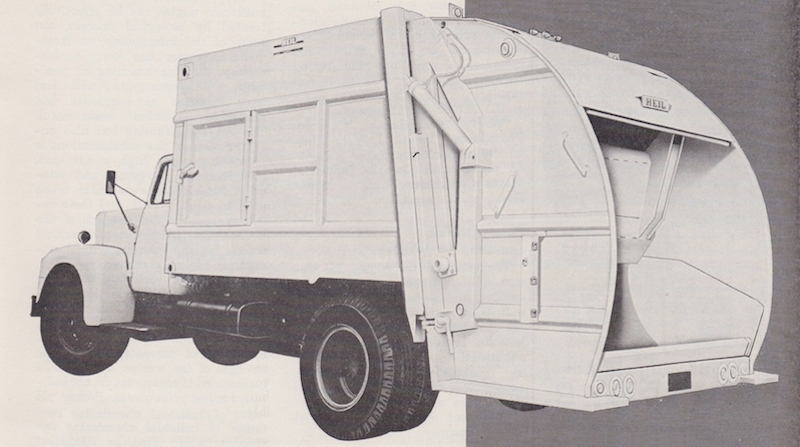
The groundbreaking Heil Colectomatic Mark II, introduced in late 1960
The first Colectomatic, rushed into production during 1953, and revised again the following year, had been successful in establishing Heil as a competitor in the maturing rear loader market of the 1950s. But the last part of the decade brought intensifying competition within the industry, with new models entering the fray, and established designs being continually improved. The Leach Packmaster received a larger, wider hopper for 1955, and the ability to handle wheeled containers. Gar Wood abandoned the original Load-Packer concept in 1957 for the radical LP-500 "Cyclomatic" series, the fastest-cycling rear loader available. Heil Company would not only rise to this challenge, it stunned the industry with a concept would completely alter the course of refuse truck design forever.
The Colectomatic Mark II was officially unveiled on August 14, 1960, during the American Public Works Association annual convention in New York City, with a special showing and luncheon held in Central Park. The operating principle remained the same as the original Colectomatic, with a hinged hopper cleared by a pivoting packer blade, but the power means were greatly simplified. The complex bell crank packer linkage was eliminated, replaced by six direct-acting hydraulic cylinders. Two double-acting rams operated the packer panel from high inside the tailgate, and a separate pair of 3-stage telescopics lifted the bucket. Two more single-acting rams, independent of the packer, now lifted the tailgate for discharge of the load. Electrically controlled, pilot-operated valves ran the entire cycle through simple push-button switches, an industry first and a dramatic technical leap for 1960. Halfway through the packer panel retract, exhaust fluid from those cylinders was routed directly to the bucket lift rams, instead of returning to the reservoir. This "regenerative" hydraulic circuit helped speed-up the cycle time. The telescopic bucket rams were sized to operate in perfect synchronization with the packer rams. The result was a powerful packer with a smooth and efficient action, a brilliant rework of the original design.
By themselves, these improvements to the packer would have been noteworthy, but Heil delivered an even bigger breakthrough with the addition of hydraulic ejection discharge, with compaction. Dubbed the Duo-Press system, it consisted of a movable barrier within the body, powered by a telescopic cylinder, the first practical use of this method in a rear loader. Gone forever were sticking payloads and the dangers of unloading large bodies on unstable ground; the Mark II simply raised its tailgate, and with a pull on the front-mounted lever, bulldozed its load out the back of the body. This feature, taken for granted today, was virtually nonexistent on rear loaders at the time. To be sure, there were earlier examples of the basic concept; The 1938 Eagle Compressmore Ejector used a telescopic-powered barrier to unload, but it's packing action was more akin to side loader, and saw limited production. Sicard came even closer in 1945 with their Sanivan, and enclosed rear-load packer which used single-stage rams and a folding ejector panel. Unlike these examples, Heil actually made the ejector panel integral to the packing process, as well as for unloading.
With the Duo-Press system, the ejector panel worked in concert with the tailgate packer mechanism in two possible ways. The simplest option was to start the load with the ejector fully forward, and as the body became filled, to cycle the panel rearward periodically, thus reducing voids in the load. The preferable method was the automatic Duo-Press, where the ejector was positioned at the rear the body prior to the start of the route. The first few packing cycles filled this reduced space, and soon began crushing the load between the packer and ejector panels. When maximum density was reached, pressure on the ejector blade caused the ejector cylinder relief valve to open, allowing the panel to creep forward slightly, and then lock again. This incremental movement against constant pressure would repeat itself until the ejector reached the front wall, obtaining uniform density throughout the entire load. Coupled to the powerful new tailgate design, the new Mark II was like nothing the industry had ever seen. Only the Leach 2-R Packmaster could match it, strictly through the brute strength of its packer, but still had the disadvantage of a tilt-to-dump body. Heil had not only come up with a "Packer for the 60s," they had in fact designed the refuse truck of the future.
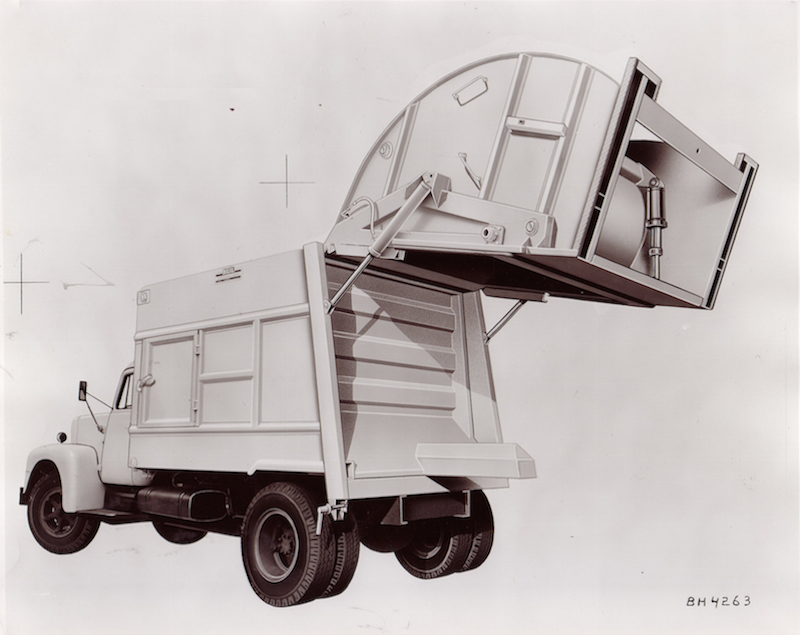
The Mark II ejector blade, which was also an integral part of the Duo-Press compaction system
Unlike the 2-R Leach, which took several years to develop its following, the Mark II was literally an overnight success, and in one year it would outsell every other previous Heil refuse body ever produced. In fact, the very first Mark II ever made, which served as the APWA show demonstrator, was sold on the spot, to the City of Middletown, Connecticut. Joseph Heil personally handed over the keys in a public relations display after the convention. Boosting its appeal was new clean and modern body styling, with an unadorned box-like simplicity. These good looks truly reflected the superb engineering of the mechanism within.
Design of the Mark II was by Heil's chief engineer, George Urban, who had also worked on development of the first Colectomatic from Mike Murphy's original patent. Later, it would be the subject of a lawsuit filed by Henry Berolzheimer, a Chicago Public Works official who claimed to have invented the Duo-Press system, and sought retroactive assignment of the patent rights. The claim was based on his 1957 meeting with Urban, as well as Joe Heil, in which he pitched his idea (unsuccessfully) for a continuous-loading type packer with a hydraulic ejector. Heil acknowledged the meeting, and drawings were witnessed at the time, but Berolzheimer's claim was for the loader mechanism, with no mention of the ejector being used as a compaction means. Straight ejection unloading did exist in prior art, further negating his claim. At best, Berolzheimer may have inspired Heil to come up with Duo-Press compaction, but the concept was not part of his proposal of 1957, and thus Heil prevailed in the case.
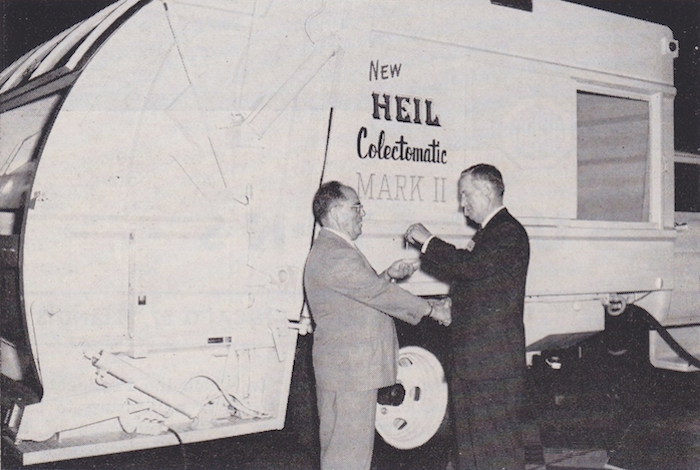
Joseph Heil hands over the keys to the first Mark II sold, at the 1960 APWA convention in New York. Buyer was the City of Middletown, Connecticut
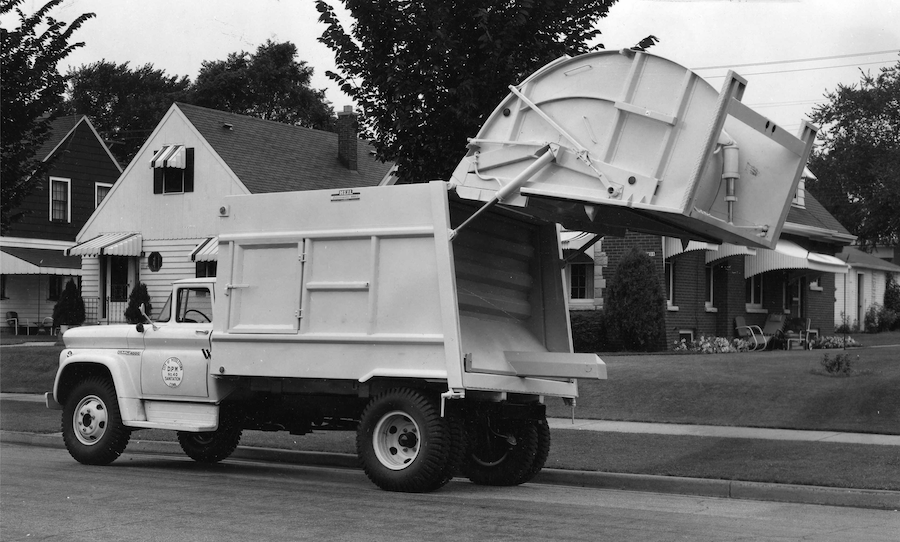
Another Mark II in service with the City of Middletown, a 16-yard body on a 1960 GMC chassis
The Colectomatic Mark II enjoyed a four-year production run, in which many minor changes were made along the way. Initial sizes were 13, 16 or 20 cubic yards, with a 25-yard model arriving in early 1962. The latter was the biggest packer Heil had ever made, and the Duo-Press system was a perfect match for the larger body. The hopper hinge point was changed in 1961 to allow for greater liquid capacity. One of the few drawbacks of the Colectomatic hinged-hopper design was its long reload time: once started, the packing cycle had to finish completely before any more refuse could be loaded in the hopper. Competitive models, such as the Gar Wood LP-600, had reload times as low as 4-seconds. The Leach Packmaster, while slower overall than either of the former, could be loaded almost continuously through its open packer linkage.
A container hoist was offered as an option on the Mark II, the first ever on a Heil rear loader. The arm-type hoist with gravity latches was electrically controlled, and could empty 1-cubic yard wheeled containers. A manually operated valve diverted fluid from the bucket cylinders to the lift arm cylinders, located on the tailgate riding steps. A folding extension of the hopper bucket was used to prevent trash falling out during the dumping of the container. The extension could be left up for hand-loading, increasing the hopper capacity slightly. The system worked well enough, but caution had to be used; if the "packer start" button was depressed while a container was hoisted, the retracting packer panel would damage the can and/or the hoist.
DUO-PRESS COMPACTION-EJECTION CYCLE
|
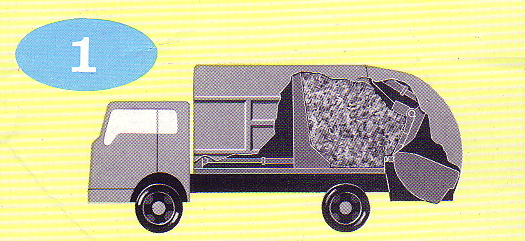
At the start of the route, the ejector plate is positioned at the rear of the body. The packer plate forces the first loads against it, until the space is filled.
|
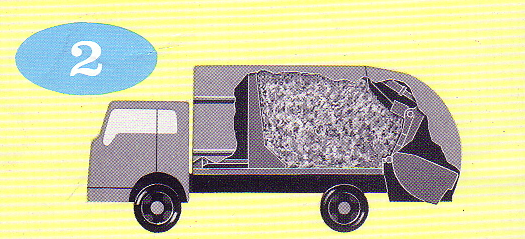
As the loading cycles continue, refuse is further compressed between the packer and ejector plates. At a pre-set pressure, the relief valve in the ejector cylinder opens, allowing the ejector to creep forward slightly.
|
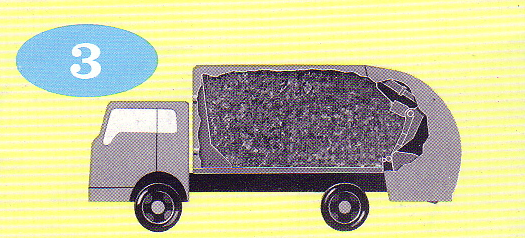
Incremental movement of the ejector continues, until it stops against the front wall of the body. Uniform compaction density is maintained from the first loads to the last
|
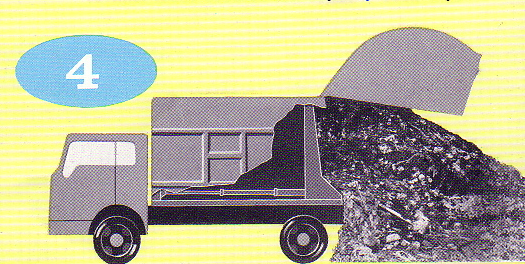
At the disposal point, hydraulic cylinders raise the tailgate, and the ejector "bulldozes" the tightly compacted load out the back, without dangerous tipping of the body
Elapsed time for the Mark II packing cycle was approximately 14-18 seconds.
|
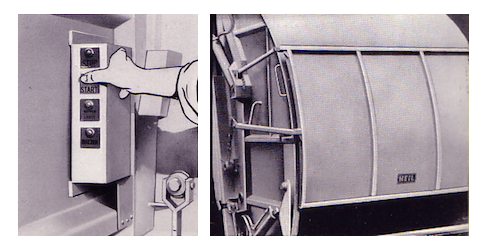 Push-button control stations were used to operate the Mark II packer. Early models had a station on each side of the tailgate, but the street-side station was eliminated around 1961. Pushing START button initiated complete packing cycle, and STOP button interrupted it during any point desired. HOPPER LOWER button dropped the hopper during any point in cycle in the event of a jam. BUZZER button was used to signal driver in cab.
Push-button control stations were used to operate the Mark II packer. Early models had a station on each side of the tailgate, but the street-side station was eliminated around 1961. Pushing START button initiated complete packing cycle, and STOP button interrupted it during any point desired. HOPPER LOWER button dropped the hopper during any point in cycle in the event of a jam. BUZZER button was used to signal driver in cab.
A spring-balanced, automatic hopper door was offered as an option in the first years. It does not appear to have been popular, and all but disappeared in a few years time.
|
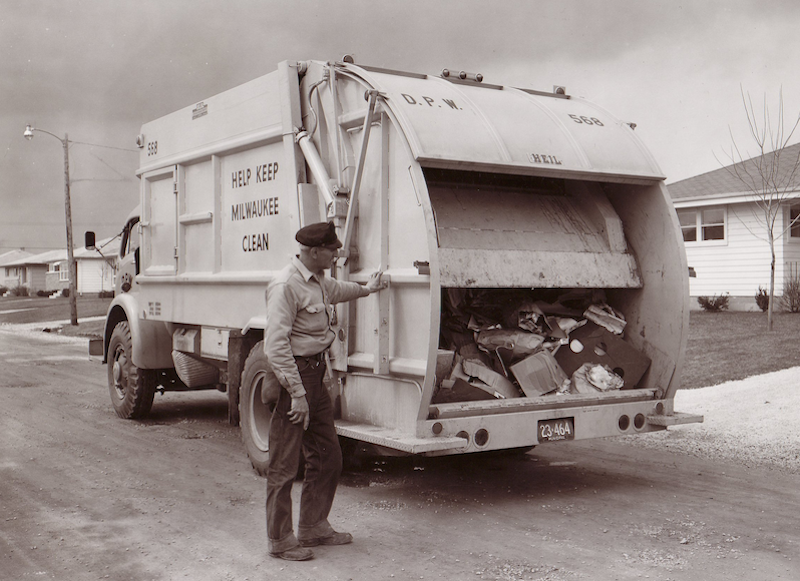
20-yard Mark II with the City of Milwaukee, initially the largest size available
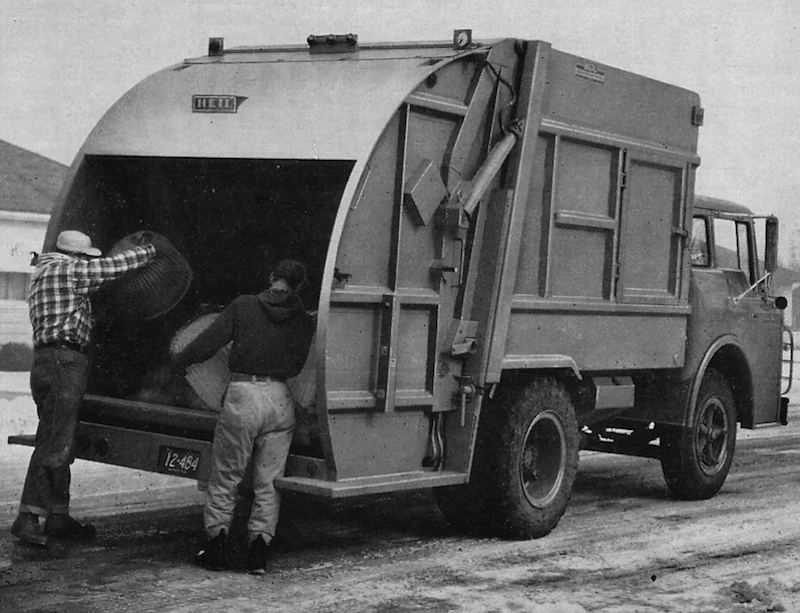
13-yard model was the smallest Mark II
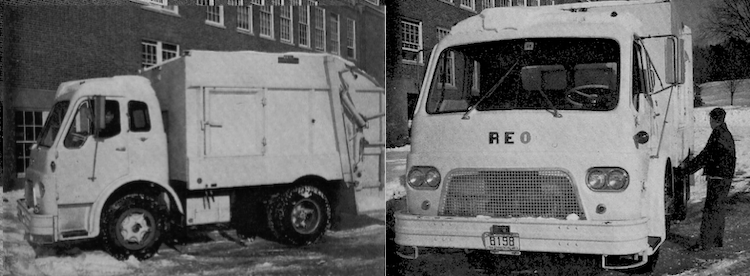
Rural New Hampshire contractor replaced an open dump truck with this 13-yard Mark II on a REO cabover truck.
At right, operator cycles the Duo-Press ejector blade to compress load inside body
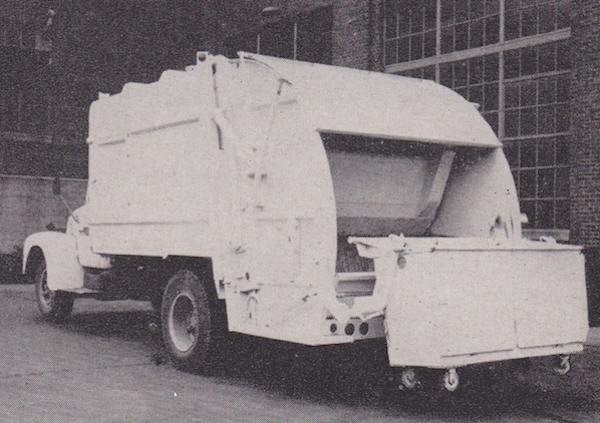
The Mark II could be fitted with an arm-type hoist, which could service 1-yard wheeled containers
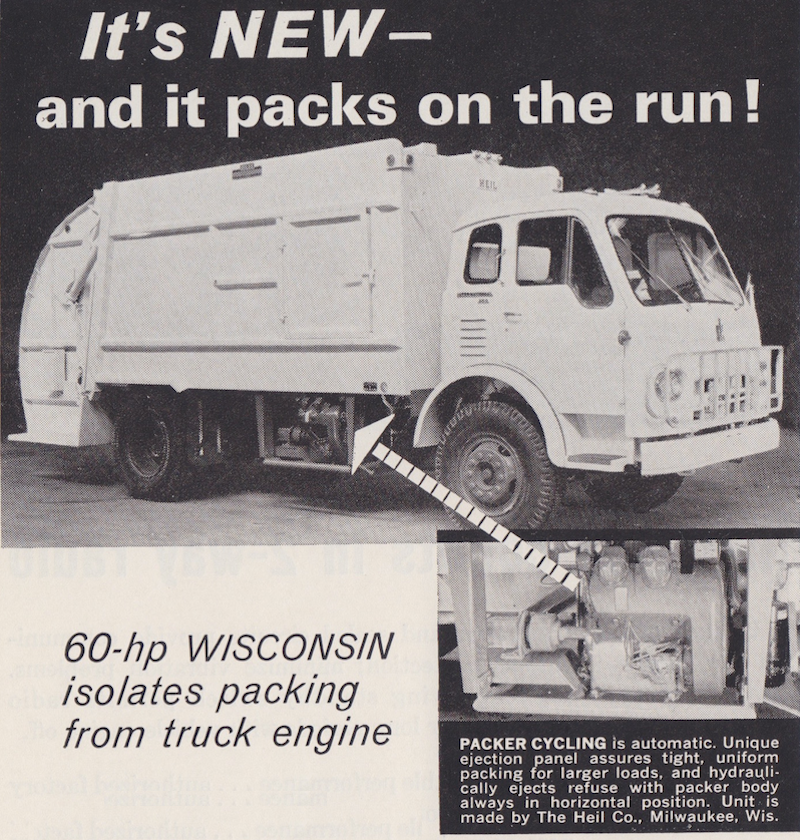
Optional air-cooled Wisconsin engine could be used to power the hydraulic pump, allowing the packer to cycle while the truck was in motion.
This was a major time-saver in the era before crankshaft-driven pumps and hot-shift PTOs
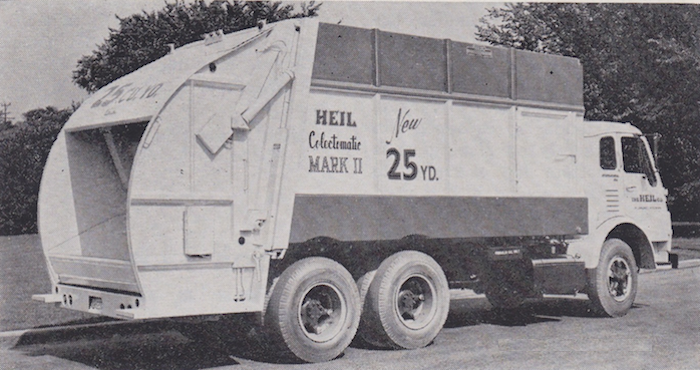
Introduced in 1962, the 25-yard Mark II was the biggest refuse packer that Heil had ever produced.
With a powerful packer and ejection discharge, this was the safest and most efficient 25-yarder on the market
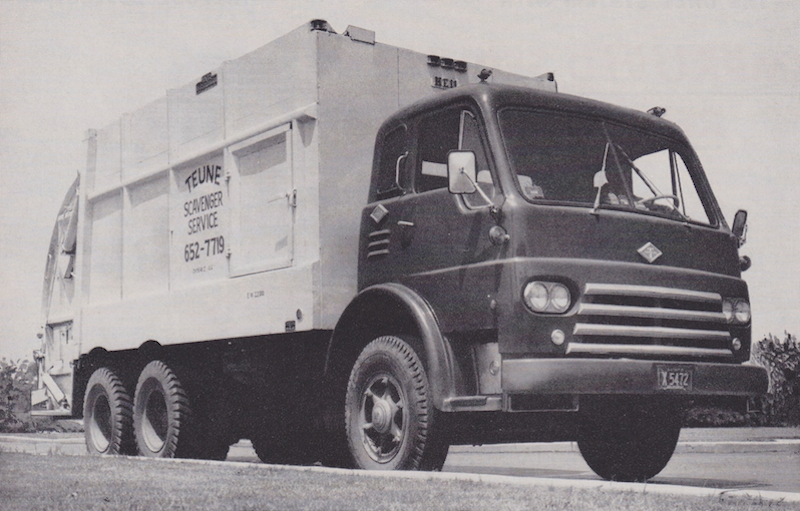
This handsome Diamond T cabover with 25-yard Mark II was owned by a Chicago-area contractor
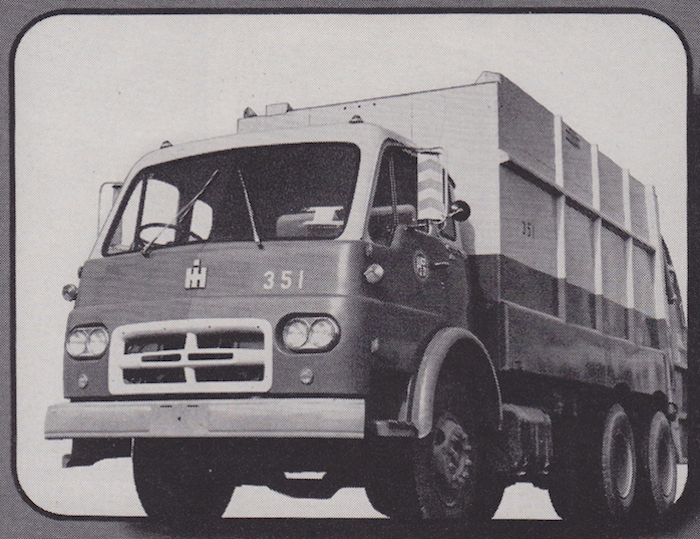
1963 International with 25-yard Mark II for the City of Los Angeles, Bureau of Sanitation, had Allison automatic transmission and right-hand drive.
L.A. also used Leach, Gar Wood and even Pak-Mor rear loaders before switching exclusively to Heil, which they bought in large numbers
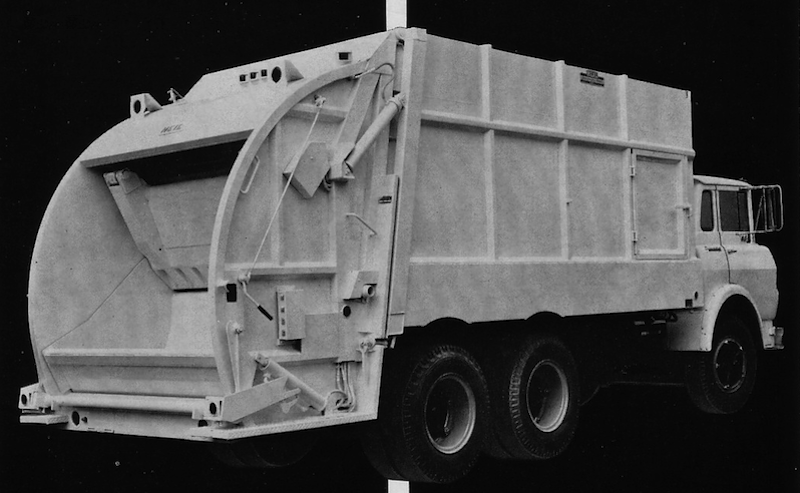
1964 was the last year for the Mark II, and many changes had been made to the body during its four year production run.
Note the reinforced edge of the packing panel on this 25-yard model, and the change in the shape of the upper tailgate;
Besides being longer, the 25-yard body was also 7" taller than other models, and thus the tailgate had to be heightened
to match up. Early 25-yard Mark II's used sheetmetal panels to hide this transition in height.
A MOMENT IN HISTORY: THE MARK II AND THE 2-R PACKMASTER

Arriving on the market within a year of each other, the Heil Colectomatic Mark II and Leach 2-R Packmaster were both game-changers in the refuse body industry, and both would have far-reaching influence. The 2-R was first (in 1959), and would re-write the books on rear-loader design and capability. Nothing could match its crushing and packing ability, and its slide-sweep type mechanism has since become an industry standard worldwide. However, the 2-R was somewhat slow to develop its dominance in the field, perhaps hindered by an aversion to advertising by Leach, and the unwieldy tilt-to-dump body used during its early production.
By contrast, the 1960 Heil Mark II was perhaps the perfect truck for its time. While never able to compete with the 2-R as a crusher, it was a still a more efficient residential refuse packer with its duo-press compaction-ejection system. This was a time when the car-eating prowess of a refuse packer was not as desirable as efficiency, light weight and economy, which the Mark II had in spades. And it could eject the load. Furthermore, the Mark II could still digest some bulk items, such as water heaters, as long as they could fit into the hopper. Consider also that plastic and paper refuse sacks were mostly unheard of in 1960, and the loose composition on household waste allowed the Mark II to deliver tremendous payloads.
The Mark II won the day during the early 1960s, and left every other competitor scrambling to come up with an ejection body. However, the 2-R slide-sweep packer was truly the packer of the future. Had Leach "miniaturized" the 2-R mechanism and mated it to an ejection body (imagine a hypothetical 1959 Leach Alpha), the story may have been quite different. Eventually, the 2-R (with Push-Out ejection) saw wider acceptance in residential collection, as users demanded both high-compaction and bulk crushing ability. At present, almost all refuse packers employ a combination of features found on these pioneering Leach and Heil designs; the 2-R slide-sweep packer and the Mark II compaction-ejection body. This fact is somewhat ironic considering the bitter rivalry between the two companies during the 1960s and the decades that followed. |
PATENTS:
|
Patent # |
Description |
Inventor |
Assignee |
Date |
|
US3049256 |
Refuse Body Loading and Packing Mechanisms (Colectomatic Mk II) |
George E. Urban |
Heil Co. |
March 23, 1960 |
REFERENCES
Justia US Law: Henry Berolzheimer, Plaintiff-appellant, v. the Heil Company, January 8, 1965
American City Magazine, September 1960, page 258 (Heil sells first Colectomatic Mark II)
|



7/2/16
© 2016
All Rights Reserved
Photos from factory brochures/advertisements except as noted
Logos shown are the trademarks of respective manufacturers
|
| |